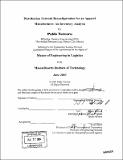| dc.contributor.advisor | James Masters. | en_US |
| dc.contributor.author | Tercero, Pablo, 1973- | en_US |
| dc.contributor.other | Massachusetts Institute of Technology. Engineering Systems Division. | en_US |
| dc.date.accessioned | 2005-09-27T17:05:55Z | |
| dc.date.available | 2005-09-27T17:05:55Z | |
| dc.date.copyright | 2003 | en_US |
| dc.date.issued | 2003 | en_US |
| dc.identifier.uri | http://hdl.handle.net/1721.1/28573 | |
| dc.description | Thesis (M. Eng. in Logistics)--Massachusetts Institute of Technology, Engineering Systems Division, 2003. | en_US |
| dc.description | Includes bibliographical references (p. 84-85). | en_US |
| dc.description.abstract | Companies in the footwear and apparel industry must deal with many supply chain challenges, including intense competition, long production lead times, reliance on international carriers, and shifting consumer preferences. For many large companies, only design and distribution are performed internally. This places pressure on footwear and apparel companies to continually improve supply chain management. This study considers a company in the footwear and apparel industry and its option to consolidate distribution for two separate regions into one. One region currently serves nine times the demand of the other region. In addition, there are differences in labor and transportation costs between the two regions. The company would like to understand the financial, operational, and service impacts associated with consolidation. This study uses a total logistics system approach with particular focus on inventory. The results indicate that if the company were to consolidate distribution for the two regions into one, then there would be a slight total logistics system cost increase. This is due mainly to differences in labor and transportation costs between the two regions. However, sensitivity analysis indicates that if some costs can be reduced, there may actually be potential savings associated with consolidating the two regions. | en_US |
| dc.description.statementofresponsibility | by Pablo Tercero. | en_US |
| dc.format.extent | 89 p. | en_US |
| dc.format.extent | 5554848 bytes | |
| dc.format.extent | 5564710 bytes | |
| dc.format.mimetype | application/pdf | |
| dc.format.mimetype | application/pdf | |
| dc.language.iso | en_US | |
| dc.publisher | Massachusetts Institute of Technology | en_US |
| dc.rights | M.I.T. theses are protected by copyright. They may be viewed from this source for any purpose, but reproduction or distribution in any format is prohibited without written permission. See provided URL for inquiries about permission. | en_US |
| dc.rights.uri | http://dspace.mit.edu/handle/1721.1/7582 | |
| dc.subject | Engineering Systems Division. | en_US |
| dc.title | Distribution network reconfiguration for an apparel manufacturer : an inventory analysis | en_US |
| dc.type | Thesis | en_US |
| dc.description.degree | M.Eng.in Logistics | en_US |
| dc.contributor.department | Massachusetts Institute of Technology. Engineering Systems Division | |
| dc.identifier.oclc | 57467940 | en_US |
